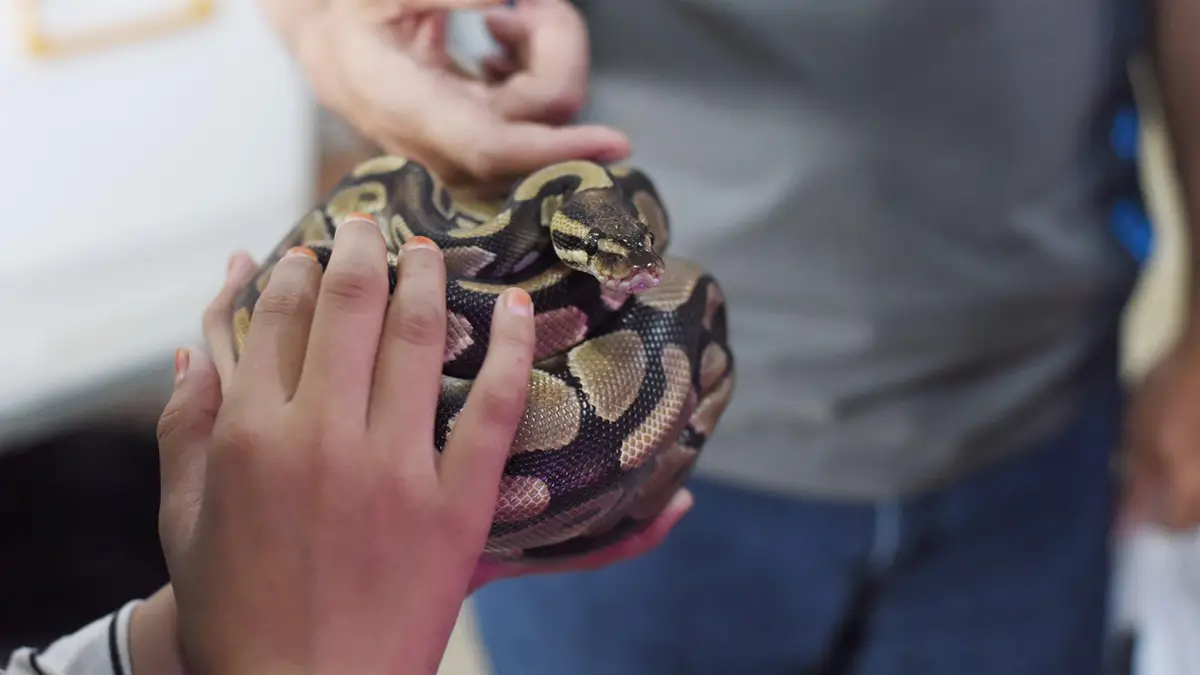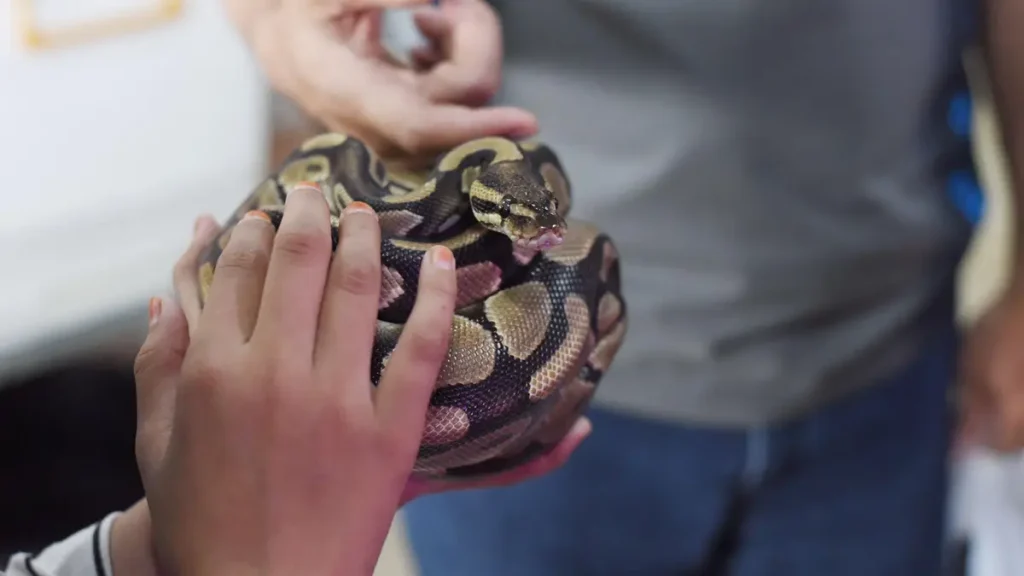Python snakes are fascinating creatures that require proper handling and care. As a snake owner, it’s crucial to understand how to handle your python safely and effectively to ensure your pet’s health and your own safety. In this complete guide, we’ll cover everything you need to know about handling your python snake, including safety tips, equipment needed, and techniques for stress-free handling.
Whether you’re a new or experienced python owner, this guide will provide you with the knowledge and skills necessary to handle your snake safely and confidently. By following our expert advice, you’ll be able to create a strong bond with your python while also ensuring their health and safety. So, let’s dive in and learn how to handle your python like a pro!
Learn how to handle your python snake safely and effectively with our complete guide. Proper handling techniques are crucial to ensure the safety of both you and your snake. Our guide covers everything from choosing the right equipment to handling and feeding your snake. With our expert tips and advice, you’ll be able to confidently handle your python snake.

The Complete Guide to Handling Your Python Snake Safely and Effectively
If you are a python snake owner, one of the most important skills you need to learn is how to handle your snake safely and effectively. Handling a python snake can be a daunting task, especially if you are not familiar with the proper techniques. In this guide, we will cover everything you need to know about handling your python snake safely and effectively.
Understand Your Python Snake
The first step in handling your python snake is to understand its behavior. Python snakes are known to be docile and calm, but they can become aggressive if they feel threatened or scared. It’s essential to observe your snake’s behavior to determine its mood before handling it. Here are some tips to help you understand your python snake better:
– Observe your snake’s body language. A relaxed snake will have a straight body, while a stressed snake will have a coiled body.
– Pay attention to your snake’s breathing. If your snake is hissing or puffing, it means it’s stressed.
– Take note of your snake’s feeding schedule. Avoid handling your snake immediately after it has eaten, as it may regurgitate its food.
Once you understand your snake’s behavior, you can begin to handle it safely.
Preparing for Handling
Before handling your python snake, you need to prepare the environment. Here are some steps to follow:
– Wash your hands thoroughly. Snakes are sensitive to smells, and any foreign scent on your hands may cause your snake to feel threatened.
– Make sure the room is quiet and free from distractions. Loud noises and sudden movements can startle your snake.
– Ensure your snake’s enclosure is secure. Your snake may try to escape if it feels threatened.
Handling Techniques
Now that you understand your python snake and have prepared the environment, it’s time to handle your snake. Here are some techniques to follow:
– Approach your snake slowly and confidently. Do not grab your snake from above as it may feel threatened.
– Use both hands to support your snake’s weight. Place one hand under the snake’s head and the other hand under its mid-section.
– Avoid squeezing your snake too tightly as it may cause it to become stressed.
– Do not handle your snake for more than 15-20 minutes at a time.
Handling Tips
Here are some additional tips to help you handle your python snake safely and effectively:
– Never handle a snake when you are sick or under the influence of drugs or alcohol.
– Always supervise children when handling snakes.
– Avoid handling your snake during shedding as it may be more aggressive than usual.
– If your snake bites you, remain calm and seek medical attention immediately.
The Benefits of Handling Your Python Snake
Handling your python snake can have several benefits, including:
– Strengthening the bond between you and your snake.
– Helping your snake become more comfortable with human interaction.
– Allowing you to monitor your snake’s health and behavior.
Handling Your Python Snake Vs. Hiring a Professional
While it’s essential to learn how to handle your python snake safely and effectively, some situations may require the help of a professional. Here are some reasons why you may want to consider hiring a professional:
– If you have a large snake that is difficult to handle.
– If your snake is aggressive or has a history of biting.
– If you are uncomfortable handling snakes.
In conclusion, handling your python snake can be a rewarding experience if done correctly. By understanding your snake’s behavior, preparing the environment, and following the proper handling techniques, you can handle your snake safely and effectively. Remember always to prioritize your safety and seek professional help if necessary.
Frequently Asked Questions
1. What are the necessary steps to handle a python snake safely?
Handling a python snake safely requires adequate preparation and knowledge of the snake’s behavior. First, you need to ensure that you are not alone and have a helper to assist you. Wear protective clothing, including gloves and long-sleeved shirts. Approach the snake slowly and confidently, and avoid sudden movements that may startle it.
Remember to always support the snake’s weight and avoid holding it too tightly. If the snake shows signs of aggression or stress, put it back in its enclosure and try again later. Always wash your hands thoroughly after handling the snake to avoid the risk of salmonella infection.
2. How often should I handle my python snake?
Handling your python snake regularly is important to keep it socialized and comfortable with human interaction. However, the frequency of handling should depend on the snake’s age and temperament. For younger snakes, daily handling for short periods of time is recommended to help them get used to human contact.
Adult snakes, on the other hand, can be handled a few times a week. It is important to note that snakes are solitary creatures and may not enjoy frequent handling, so be sure to monitor their behavior for signs of stress or discomfort.
3. How can I tell if my python snake is stressed?
Stress in python snakes can manifest in various ways, including loss of appetite, lethargy, and aggression. If your snake is not eating or drinking, appears to be hiding more than usual, or is excessively defensive or agitated, it may be experiencing stress.
Other signs of stress include excessive shedding, unusual movements, and regurgitation. If you suspect that your python snake is stressed, it is important to identify and address the cause of the stress, whether it be improper handling, inadequate enclosure, or an underlying health issue.
4. What should I do if my python snake bites me?
If your python snake bites you, remain calm and gently remove the snake’s teeth from your skin. Clean the wound thoroughly with soap and water and monitor it for signs of infection. Seek medical attention if the bite is deep or if you experience allergic reactions or symptoms such as fever or swelling.
It is important to note that while python snake bites can be painful, they are rarely life-threatening. To prevent future bites, be sure to handle your snake safely and avoid sudden movements or loud noises that may startle it.
5. How can I ensure the safety of others around my python snake?
When handling your python snake, it is important to ensure the safety of others around you. Always keep your snake away from children and pets, and never leave it unattended outside of its enclosure.
Be sure to inform others of the risks associated with handling snakes and the importance of proper handling techniques. Additionally, it is a good idea to have a plan in place in case of emergencies, such as a snake escaping from its enclosure or biting someone.
In conclusion, handling a python snake may seem daunting, but with the right knowledge and precautions, it can be done safely and effectively. Remember to always approach your snake calmly and confidently, and to avoid sudden movements or loud noises that may startle it. Use the proper equipment such as gloves, tongs, and a secure enclosure to ensure your snake stays safe and secure during handling. And most importantly, take the time to get to know your python snake and its unique personality, as this will help you build a strong and trusting relationship with your pet. With these tips in mind, you can enjoy the many joys of owning a python snake while keeping both you and your pet safe and happy.


